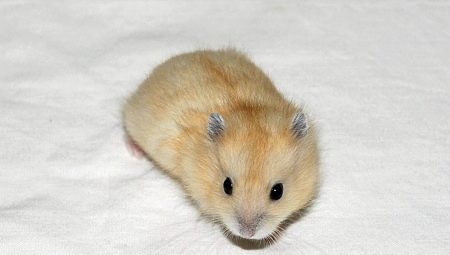Dzungarian hamsters are very friendly, easily tamed, require little feed, so they are often bred as pets. However, they have a very short lifespan, they are active in the evening and at night, they require separate maintenance from each other (the exception is the kids - they cannot be separated from their mother until they open their eyes). Before acquiring hamsters, it is necessary to take into account all the features of their lifestyle, so as not to regret the acquisition in the future.
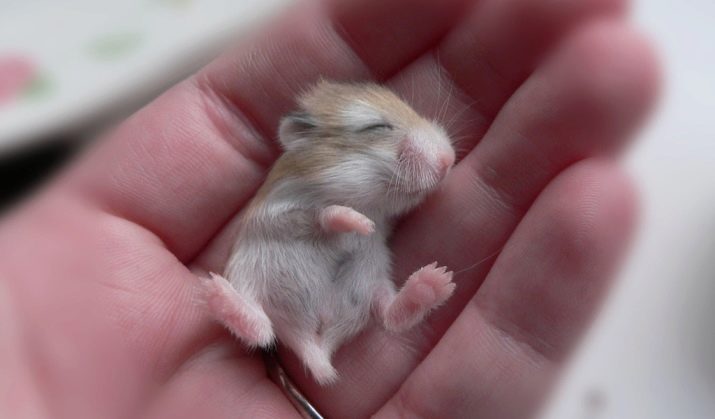
At what age does reproduction begin?
Breeding this type of hamster is quite simple - it is only necessary to create favorable conditions, choose the right moment and follow some recommendations.
Puberty in the Dzungarian hamsters occurs in 2 months, but it is better to wait another month, so that not only maturity occurs, but the individuals have time to get stronger. More healthy offspring can be obtained from the union of a three-month-old male and a five-month-old female. Early pregnancy has an extremely negative effect on the female’s health and can cause shock and subsequent infertility.
A female ready for fertilization will often raise her tail in the evening and squirrel with a strong smelling substance. It is at such a moment that it is most advisable to combine hamsters for mating in neutral territory. If there is no possibility of mating in a separate cage, you need to plant a female on the territory of the male, but in no case not vice versa.
Before replanting, it is recommended to do a general cleaning in the cage in order to wash off the smell of the owner and reduce the conflict situation.Males are less aggressive in responding to the temporary seizure of their territory and are more interested in mating than females.
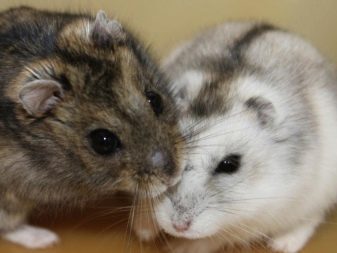

Mating, as a rule, occurs at night, during the time of the greatest activity of hamsters. In a day or earlier (if a conflict began between individuals), they must be planted in their cells. After mating, animals need to be provided with enough food and water to restore strength.
If, after 4-5 days, the female begins to squirrel again with the enzyme, the mating must be repeated.
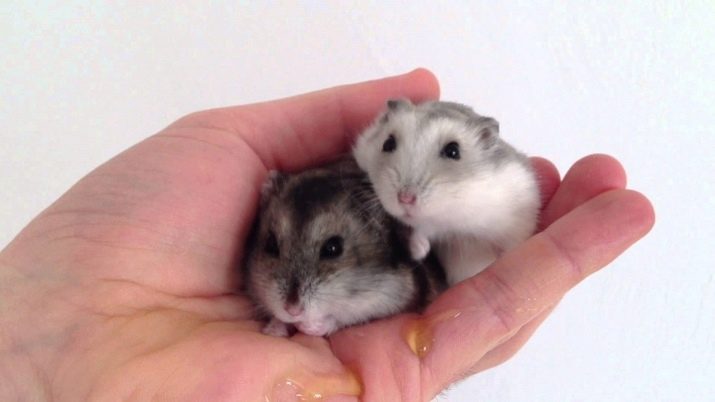
Couple selection
With the aim of frequent and regular obtaining healthy offspring most optimally contain 1 male and 3 females.
It is best to buy future parents from different owners or in different pet stores in order to be sure that the couple is not related. It is preferable to take Dzungarian hamsters for the purpose of further breeding from the breeder, because professionals with a good reputation always observe the correct conditions of detention, keep strict records of offspring and give the babies away from different pairs.
At the time of purchase, the animals should be of uniform color with shiny hair, clean eyes and ears, the weight of the individuals should be about 40 g, age - from one to two months.
Both parents must be strictly of the same kind. (there are very similar Campbell's hamsters). The Dzhungar hamsters have a clearly defined black rhombus on their heads, and the whole color is bright and clear. At Campbell, the coat itself is a little wavy, and due to this, they seem tousled, the color is blurry.
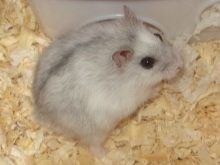
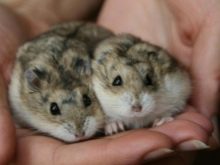
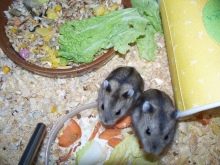
You can’t mate Dzungar hamsters of the same exotic color (two tangerine or pearl), since their offspring will be unable to reproduce, because such types of coloring were bred artificially. For this reason, you need to pair hamsters of different colors or two individuals of a classic black and gray color.
Creation of suitable conditions
At home, before breeding, the female and the male must be kept in different cages, as Dzungarian hamsters are very aggressive towards relatives in their territory. At the time of mating, it is best to use the third cell and launch the future parents into it at the same time.
The mating cage should be spacious, and the temperature in the room should be 20-25 degrees Celsius. In addition to the house, feeders and drinking bowls, there should be no distracting elements (stairs, pipes, toys). It is advisable that the mating take place in a quiet separate room, where there are no drafts, at a sufficient distance from heating appliances and in isolation from other domestic animals.
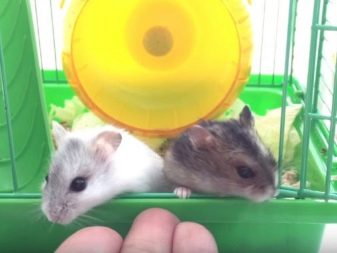
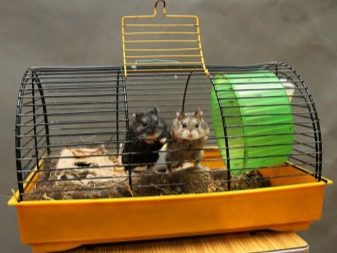
It is most optimal to use a one-story cage with a simple house for breeding in a couple to retire for breeding Dzhungar individuals of the house (you can put a little bit of chumiza in the house - a favorite treat of hamsters). At the bottom of the cell, it is better to place shavings of fruit trees with a layer of 5-7 cm.
After successful mating, the female of the Dzungarian hamster will become pregnant and begin to build a nest, therefore it is necessary to provide her with special materials: flax, hay, fresh shavings of fruit trees. It is contraindicated to give napkins, cotton wool, newspapers, colored boxes to avoid injuries and poisoning the future mother.
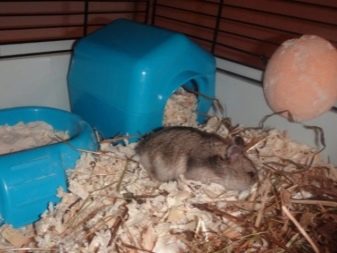
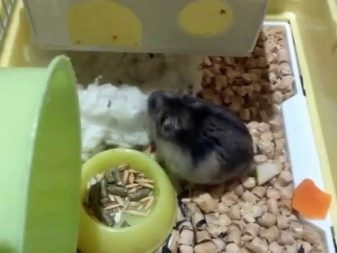
How to determine pregnancy?
It is possible to understand whether a female is pregnant on the 10th day after mating by simple signs (until the tenth day the female looks as usual and you can’t find out anything): her belly will become round, her appetite will noticeably increase. She will rarely leave the house, evening and night activity of the animal will decrease.
After pairing, it is necessary to remove the ladders, wheel, pipes and access to the 2-3 floor of the house in order to prevent possible female injuries. Also, the expectant mother needs complete peace - any manifestation of stress can be perceived as a threat to the offspring, and the female will exterminate the babies.
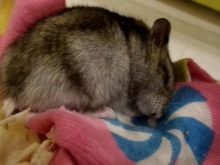
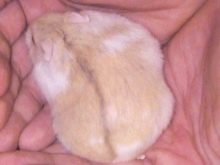
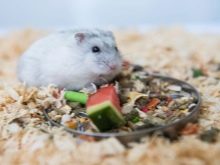
The female, while she is walking pregnant, needs enhanced nutrition, in which there must be a minimum of dry food, and most of it is boiled egg protein, boiled chicken finely chopped meat, baby food from jars (with meat ingredients). Also during this period, you must constantly keep in the cage chalky mineral stone.
Pregnancy in Dzungarian hamsters does not last long, but, despite this, the embryos manage to form and gain sufficient weight during intrauterine development.
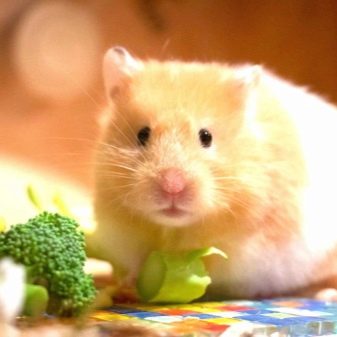
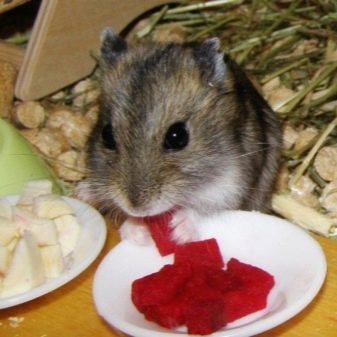
How is it going?
Pregnancy in these individuals is unremarkable, with the exception of a decrease in female activity. Her pregnancy lasts from 21 to 26 days (in the absence of pathology). Before the birth, appetite disappears.
Around the middle of pregnancy, a female begins a nesting period - arranging a house for children. You need to try not to disturb her once again, even if you are very curious to look inside (it is better to watch a video on the Internet on this subject).
If an early birth occurred or vice versa, the gestation period was delayed, then the animal should be shown to the veterinarian as soon as possible.
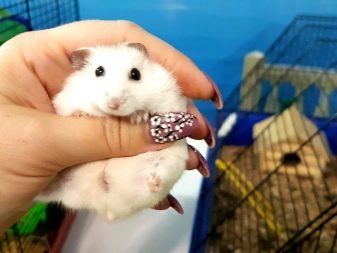
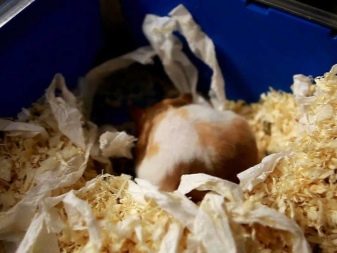
On the 18th day after the onset of pregnancy, a full cleaning of the cell should be done, but try not to touch the house with the nest (remove food residues, replace chips, wipe the bottom and rods with a clean damp cloth, thoroughly wash the drinker and feeder).
Childbirth
When the time of birth is suitable, it is strictly forbidden to interfere with the process or move the cage - it is desirable that the animal is alone in the room. Normally flowing birth in Dzhungar hamsters lasts about two hours, babies are born one at a time with an interval of about 15 minutes.
If many hamsters are born at once (10-12 individuals), you can help mom:
- it is necessary to take the baby with a clean and warm teaspoon (you can not touch the newborns with your hands);
- shift on a paper towel and remove the amniotic sac;
- cut the umbilical cord with disinfected manicure scissors (you should step back a few millimeters from the tummy);
- return the baby to the nest for the rest of the children.
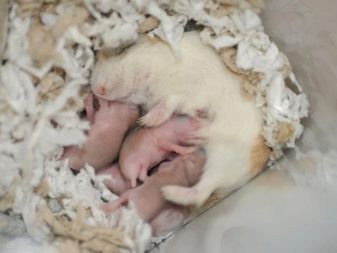
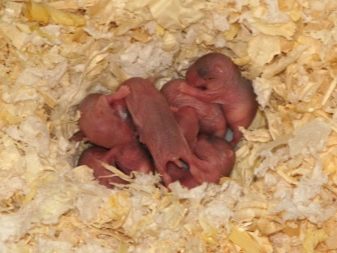
After 30 minutes after the end of the birth, the first feeding of the babies with mother's milk should occur.
Before the next pregnancy, the female needs rest. The next mating can be carried out no earlier than a month after the previous birth, otherwise the new offspring may be weak and painful, and the female will cease to become pregnant at all.
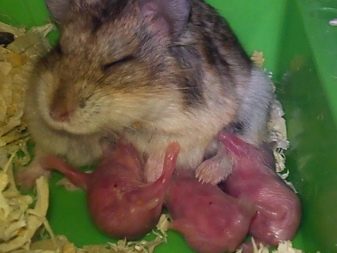
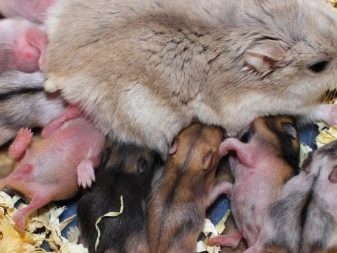
Care after the offspring
A cage (preferably a showcase) for a mother with newborn babies should have a minimum size of 60 by 40 cm and be in a quiet, slightly darkened place. In no case can a male be planted: the mother will fight with him over her territory, the babies will prevent new mating, and the male will begin to take out his aggression on the newborn, and very often the males gnaw out the entire litter.
The cage should have a drinking bowl, as well as a feeder and a wheel for mother to rest from motherhood and to avoid nervous exhaustion of the female.
Mom hides newborn babies in the nest. They are born with closed eyes, with a complete lack of hair, but with teeth. A nursing mother constantly needs clean water in a drinking bowl (you need to replace it once a day in the afternoon).
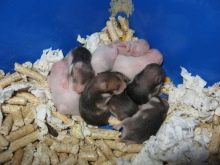
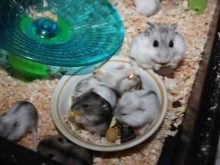
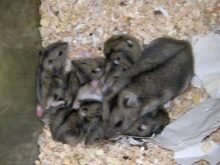
Before the onset of two weeks of age, the mother takes care of the babies completely and completely. But if one of the kids crawled out of the nest, then you can not take it with your hands.
You can return the fugitive with a regular teaspoon. To do this, rinse the spoon with warm water, shake it well and gently pick up the baby, and then with extreme caution return it to the nest.
If you take the hamster with your hands, then a foreign smell will adversely affect the female, which will be a sign of the threat of invasion of the nest, and she will bite the baby. You can touch small hamsters only when they are 2 weeks old, but you need to disturb them as little as possible.
If the female left the babies, it is not possible to feed them all, since they need to be looked after around the clock, maintained at a constant temperature of 25 degrees in the nest and fed the nutrient mixture to all newborns at the same time every two hours for two weeks (such babies will be weak, shy and incapable to reproduction). Until the kids open their eyes, cleaning in the cage is not recommended (the exception is the replacement of feed and water). It is also necessary to refrain from swimming in the sand until the end of feeding.
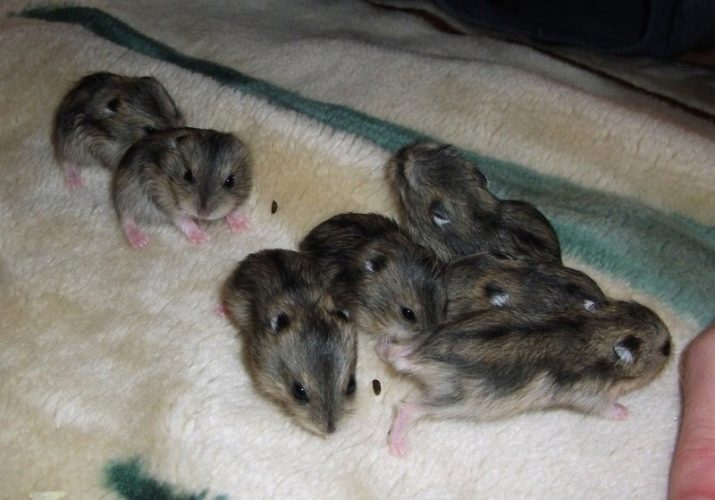
If the female begins to show aggression towards the cubs after they open their eyes, then they should be put in a separate cage or box, continue feeding with baby food from jars, and drink water from a pipette. If the female behaves calmly, then the babies should live with her for 21 days, after which they need to be separated by sex and planted in two separate cages or boxes.
When the babies turn 2 months old, they can be handed out. Be sure to notify the new owners about the baby food (brand), litter (linden shavings are best), twigs for grinding teeth (preferably thin dried currant branches). For the best adaptation in a new place, it is recommended to give along with the hamster a part of the litter, as a familiar smell will help reduce the stress of the animal when moving. The first 3 months it is undesirable to give goodies, with the exception of a boiled egg and a slice of fresh apple.
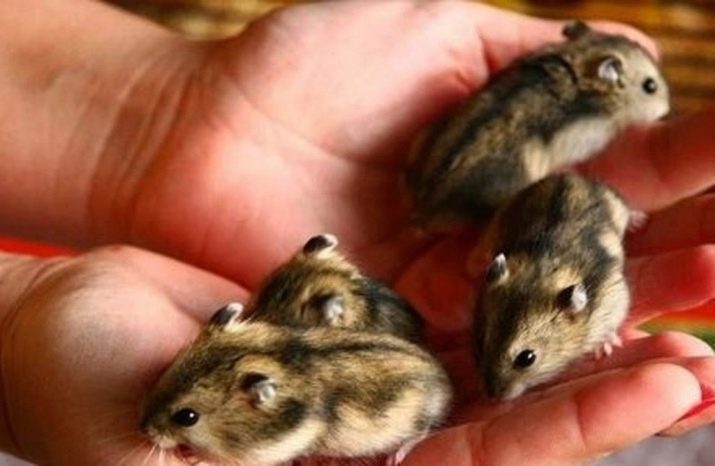
Life expectancy of Dzungarian hamsters is very short: only 3 years. However, with the correct content, the animal will delight its owner all this time and actively breed.
See how the Jungar hamsters breed in the next video.
